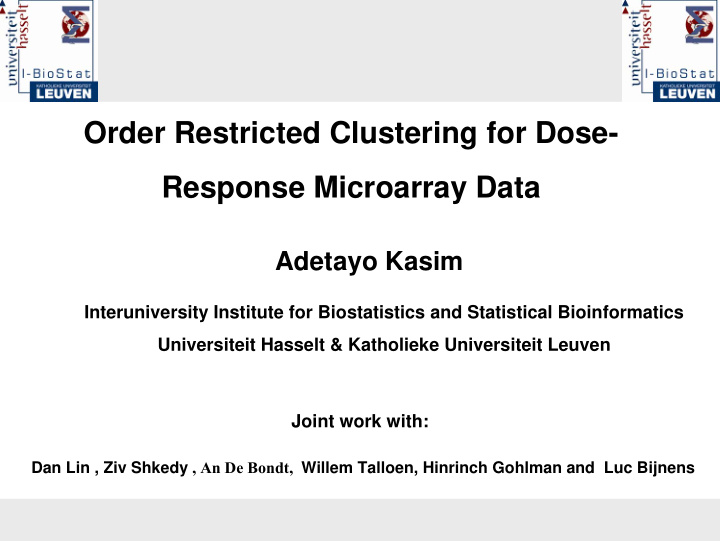



Order Restricted Clustering for Dose- Response Microarray Data Adetayo Kasim Interuniversity Institute for Biostatistics and Statistical Bioinformatics Universiteit Hasselt & Katholieke Universiteit Leuven Joint work with: Dan Lin , Ziv Shkedy , An De Bondt, Willem Talloen, Hinrinch Gohlman and Luc Bijnens
Outline of Presentation Introduction δ - biclustering Clustering of Dose-response data Application to Data Conclusion
Introduction Dose-response microarray experiments Monitoring of gene expression with respect to increasing dose of compound To establish a dose-response relationship. To determine the shape of the relationship To identify the minimum effective dose.
Introduction Structure Dose-Response Data ⎛ ⎞ L A cell line was treated with y y y 1,1 1,2 1, p ⎜ ⎟ 3 compounds L y y y ⎜ ⎟ 2,1 2,2 2, p ⎜ ⎟ M M O M 4 doses per compound ⎜ ⎟ ⎜ ⎟ L y y y ⎝ ⎠ 3 rats per dose ,1 ,2 , n n n p 16,998 genes
Introduction Related Works Testing for trend in dose-response microarray experiments – Lin et al., (2007a) Classification of trends in dose-response microarray experiments using information theory selection methods. - Lin et al., (2007b)
Self organizing maps (SOM) Hierarchical clustering Introduction K-means Clustering
Introduction Biclustering clustering of genes under subset of conditions Madeira and Oliveira, 2004 reviewed biclustering methods δ − biclustering (Cheng and Church, 2000)
δ - Biclustering δ - Model Criterion = μ + α + β + <= δ x r H ij i j ij IJ δ >= Similarity Score 0 2 r ∑ = ij H IJ | I || J | , i j
Clustering of Dose-response Data
Clustering of Dose-Response Data Model Example For Each gene; = μ + ε ( ) y d jk j jk Ordered Constraints μ ≤ μ ≤ μ L 1 2 p or μ ≥ μ ≥ μ L 1 2 p
Clustering of Dose-Response Data Clustering using observed data and isotonic means = μ + α + β + * y r ijk i j ijk Clustering using only isotonic Means μ = μ + α + β + * ( ) d r i j i j ij
Clustering of Dose-Response Data δ - Choice of δ clustering clustering of genes under all δ = λ * H conditions relative choice for delta ≤ λ ≤ 0 1 specification of minimum members of a cluster (phi)
Clustering of Dose-Response Data δ - Algorithm 1: clustering Input: , a matrix of real number; , minimum number of genes in a cluster; and Output: , a subset of Y with rows set and Column set ; with score not larger than or δ = λ Initialization: , where * H is the mean squared H residue score of the observed data.
Clustering of Dose-Response Data δ - Algorithm 1: clustering Iteration : 1. Apply node deletion algorithm of Cheng and Church (2000) only in gene direction with fixed conditons/dose levels. 2. if mean squared residue score of the reduced matrix satisfies criterion or number of genes in the reduced matrix is at most , then output the reduced matrix as a cluster. 3. Delete members of cluster found in step 2. 4. Repeat Steps 1 to 3 on the non-clustered gene until every gene belongs to a cluster.
Clustering of Dose-Response Data Algorithm 2: Order restricted clustering based on observed data and isotonic means Input: , a matrix of real number; a matrix of isotonic means, minimum number of genes in a cluster; and Output: , a subset of with rows set and Column set ; with score no larger than or
Clustering of Dose-Response Data Algorithm 2: Order restricted clustering based on observed data and isotonic means Initialization: , where δ = λ * H is the mean squared H residue score of the observed data. Iteration : 1. Using global likelihood ratio statistics, assign each gene to a direction = μ + α + β + * y r 2. Apply Algorithm 1 using model; ijk i j ijk
Application to Data Initial Filtering Global likelihood ratio test – Lin et al, (2007) Clustering only significant genes
Application to Data Observed Data and Isotonic Means
Application to Data Isotonic Means
Application to Data Choice of Lambda and phi Down up
Conclusion fast exploratory tool for dose-response microarray data resulting clusters have intrinsic ordering quality and number of clusters depends on choice of lambda and phi the method can be used with or without initial filtering
THANK YOU
Recommend
More recommend